
Features
Flowers
New Varieties
Retail
Trial by fiery hot conditions
Find out which trialled varieties survived long stretches of high temperatures, and what exciting changes are in store for 2021.
October 20, 2020 By Melhem Sawaya
 The Sawaya Garden Trials’ open house will be making some changes in 2021, tracking other factors that contribute to a variety’s success.
The Sawaya Garden Trials’ open house will be making some changes in 2021, tracking other factors that contribute to a variety’s success. COVID-19 did not affect our trials, but we were forced to hold the open house over a longer period of time.
Visitors had to register in advance to limit the number of people visiting per day, which turned out to be a much better experience for the attendees because they were able to concentrate on the trials rather than visit with friends and industry acquaintances. Counting the visitors through the different days, the numbers surpassed other years and most, if not all, were from Canada. All in all, we learned from the situation forced upon us.
The other semi-expected surprise was the charity plant sale, which we have held each year for the past 20 years. This year, the total amount raised was double compared to our best previous years. Yes, plants were in demand.
Towards lasting cultivars: Changes to the trials
This was the 20th year for the trials, and many cultivars have come through since. Some have been in production for 20 plus years and are still going strong; others have not made it past one or two seasons. Granted, even though many of the cultivars have kept the same names, they have gone through many improvements over the years. By improving minor characteristics to ensure consumer satisfaction, breeders are producing winning cultivars.
Through my 42 years in the horticulture business working with breeders, growers, buyers, and consumers, I have learned what it takes to create a successful cultivar that can stand the test of time.
Every season, I share some cultivars that performed well through the trialling period, but come next season, some of them are never mentioned again while others are mentioned over and over. This is because there are other factors that make a successful, lasting variety.
For the past 20 years, the Sawaya Garden Trials have concentrated on garden performance, which is extremely important. However, starting next year, we will be tracking other factors that make a cultivar successful in the long run. These include:
- Source starting material: availability; delivery; quality; per cent germination/propagation; pest-free
- Point of purchase: presentation; shelf-life; in-store abuse; ease of care; consumer’s first impression
- Trial garden performance: True to family/series performance (similar habit); plant habit; longevity in appearance; plant body (foliage health and habit); flower power performance (length and regeneration); rain recovery time; drought tolerance; deadheading requirement; garden appeal from 1 metre and from 10 metres; disease and insect resistance; fragrance; colour appeal
Taking all these factors into consideration, the Sawaya Gardens’ next phase is to:
- Evaluate all participating varieties using a numbered grading scale.
- Work with breeders on variety selection by trialing potential market introductions using the parameters mentioned before.
- Establish a production cookbook for each new introduction, created for growers.
- Conduct market testing on a small scale.
This will accomplish the following:
- Breeders will not have to spend a large amount of capital on varieties that will not make it past one or two years.
- Growers will not have to grow a variety that does not pass the aforementioned criteria. This will avoid wasted capital and allow better use of greenhouse space for tested varieties.
- Buyers will not be tempted to order an exclusive variety that either i) the grower does not produce efficiently or ii) does not have confirmed consumer appeal.
- The consumer will buy a variety that they will likely enjoy, rather than be disappointed by plant performance and be turned away from buying plants completely.
In addition, Sawaya Gardens will open its doors to the public through educational tours, so we can equip consumers with practical knowledge of variety choices and knowledge of plant care.
To accomplish all this, the trial site will be moving to a new location. A greenhouse structure is being built to help answer as many questions as needed by the horticulture industry.
Any suggestions for trial set-up, communication of information, or other topics are all welcome.
Variety highlights: Part 1
Here are some varieties that I’d like to share with you from this year’s trials. These are by no means the only great performers from the trials, but due to limited space, 24 varieties are being shared in this issue with more to come.
This year’s weather has to be one of the hardest I’ve seen on plants. Things got off to a cold start, then came a long stretch of temperatures in the mid-30’s and winds that knocked over many plants more than once. The plants that survived it all were excellent performers.
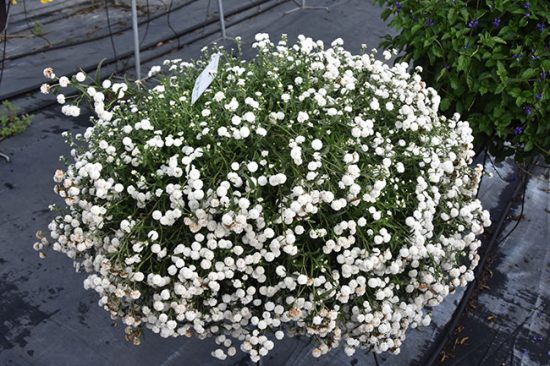 [1] Achillea millefolium Summer Drift is an excellent garden performer that is covered with masses of white blooms. A perennial for zones 5 to 8. Great in combinations, it could take the place of Bacopa with its excellent heat tolerance. No vernalization needed; first-year flowering.
[1] Achillea millefolium Summer Drift is an excellent garden performer that is covered with masses of white blooms. A perennial for zones 5 to 8. Great in combinations, it could take the place of Bacopa with its excellent heat tolerance. No vernalization needed; first-year flowering.
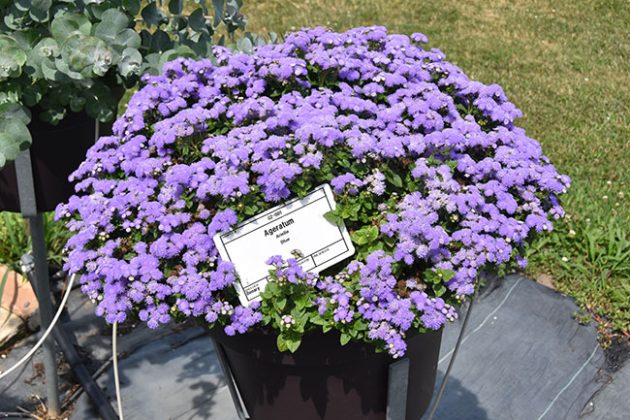 [2] Ageratum Ariella Blue is a fairly compact plant with masses of beautiful blue-coloured blooms that last for a long time without browning. Excellent in gallons for planting landscapes or large patio pots. Easy to grow with flowers that are disease-resistant, even with overhead watering.
[2] Ageratum Ariella Blue is a fairly compact plant with masses of beautiful blue-coloured blooms that last for a long time without browning. Excellent in gallons for planting landscapes or large patio pots. Easy to grow with flowers that are disease-resistant, even with overhead watering.
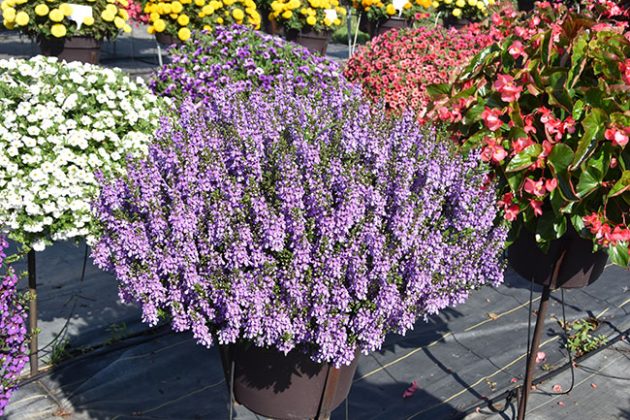 [3] Angelonia Serena Blue Improved is one colour of the Serena Angelonia series that flowers all season long without any deadheading, making it an excellent choice for landscape gardens, in large patio pots or in mixes as we will see later on. It is not heat-tolerant, but it is heat-loving, and it thrives in full sun with high temperatures.
[3] Angelonia Serena Blue Improved is one colour of the Serena Angelonia series that flowers all season long without any deadheading, making it an excellent choice for landscape gardens, in large patio pots or in mixes as we will see later on. It is not heat-tolerant, but it is heat-loving, and it thrives in full sun with high temperatures.
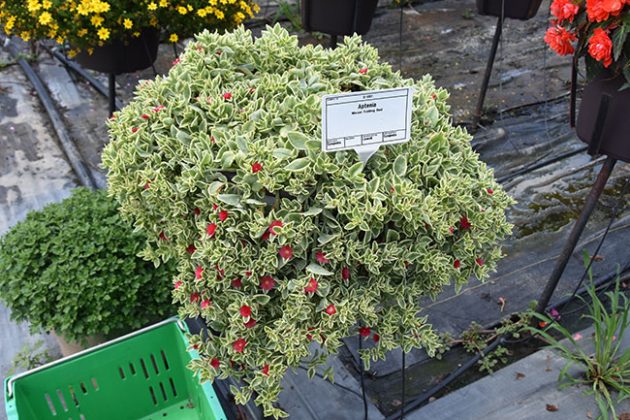 [4] Aptenia Mezoo Trailing Red was a favourite among trial visitors. From the waxy variegated leaves emerge tiny red flowers later in the season. It can adjust to variable weather conditions but excels in high light and high temperatures. Great in large baskets and in combinations.
[4] Aptenia Mezoo Trailing Red was a favourite among trial visitors. From the waxy variegated leaves emerge tiny red flowers later in the season. It can adjust to variable weather conditions but excels in high light and high temperatures. Great in large baskets and in combinations.
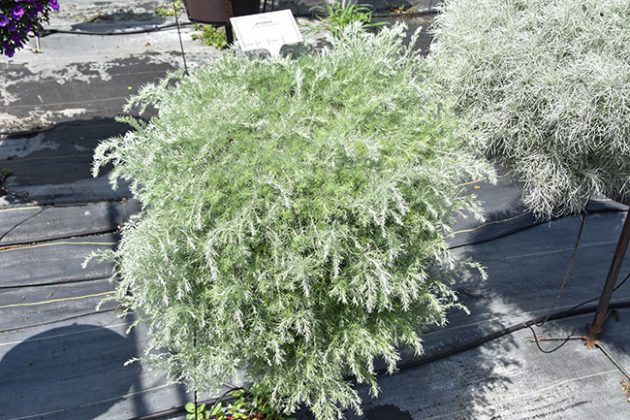 [5] Artemisia glacialis (Gletscherraute). Silvery smooth, feathery trailing leaves beg to be used in combinations, making them stand out. Excellent garden performance gets better with age. Great in combinations or in large hanging baskets.
[5] Artemisia glacialis (Gletscherraute). Silvery smooth, feathery trailing leaves beg to be used in combinations, making them stand out. Excellent garden performance gets better with age. Great in combinations or in large hanging baskets.
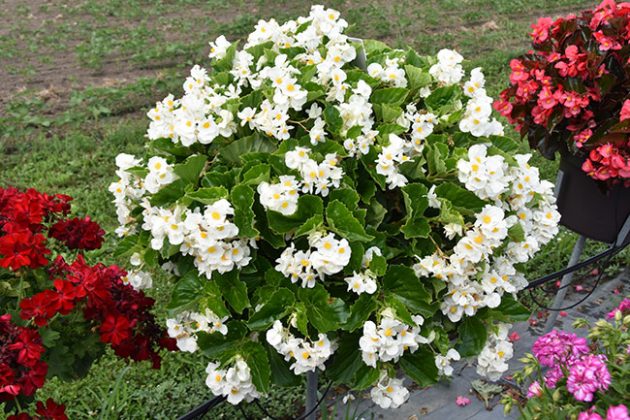 [6] Begonia x Benariensis Big White Green Leaf. At last, a large white begonia to complement the other colours. Big White is vigorous with sturdy stems that stood up to the extremely high winds in our trials. A natural for large patio pots and a superb landscape item.
[6] Begonia x Benariensis Big White Green Leaf. At last, a large white begonia to complement the other colours. Big White is vigorous with sturdy stems that stood up to the extremely high winds in our trials. A natural for large patio pots and a superb landscape item.
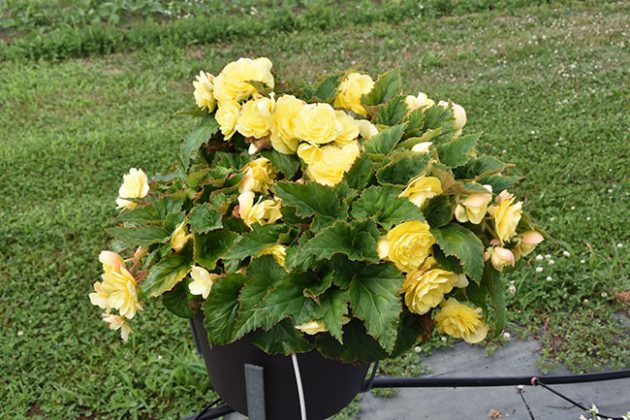 [7] Begonia x Tuberhybrida Nonstop Joy Yellow has a semi-cascading habit with bright flowers that can survive full sun when adequately watered and great in the shade. Because of the semi-cascading habit, it’s excellent in combinations that need to be grown in shaded places.
[7] Begonia x Tuberhybrida Nonstop Joy Yellow has a semi-cascading habit with bright flowers that can survive full sun when adequately watered and great in the shade. Because of the semi-cascading habit, it’s excellent in combinations that need to be grown in shaded places.
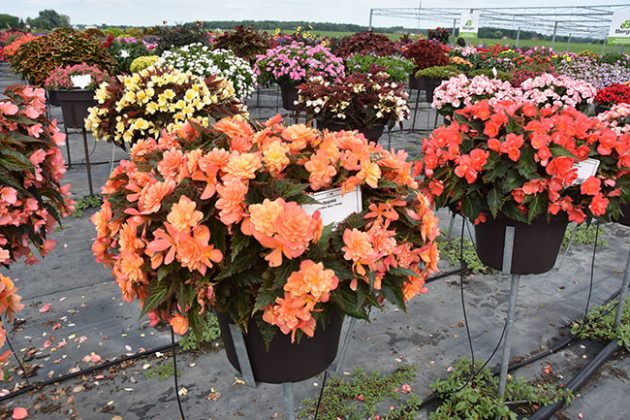
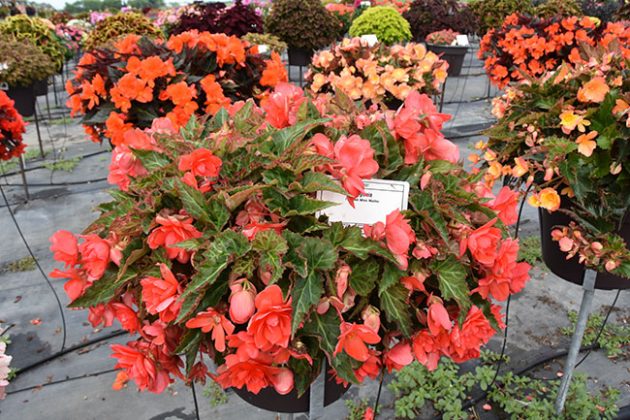 [8] Begonia I’CONIA Bacio Orange and [9] Begonia I’CONIA Miss Malibu are two of the Boliviensis begonias that are great in the shade but excel in full sun. Double, long-lasting flowers are excellent at regenerating new blooms throughout the whole season. Time to slow down on the Rieger begonias and take on the vast varieties of Boliviensis begonias either alone or in combinations.
[8] Begonia I’CONIA Bacio Orange and [9] Begonia I’CONIA Miss Malibu are two of the Boliviensis begonias that are great in the shade but excel in full sun. Double, long-lasting flowers are excellent at regenerating new blooms throughout the whole season. Time to slow down on the Rieger begonias and take on the vast varieties of Boliviensis begonias either alone or in combinations.
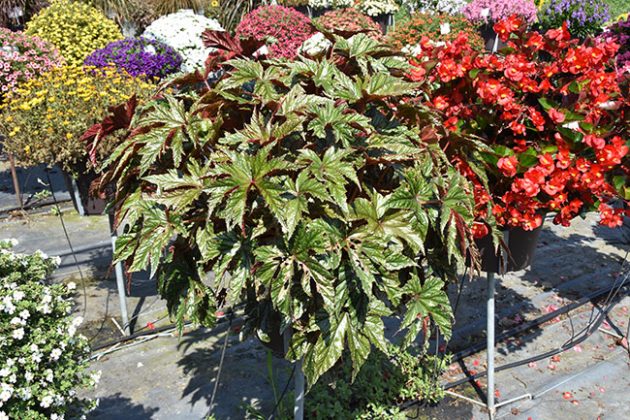 [10] Begonia Gryphon is a begonia that stands out for its upright mosaic foliage; a classy show that can go indoors or outdoors in shade or sun. Gryphon is great to grow in gallons meant for landscapes or even large patio pots where a pair can make any entrance look great. Easy care, drought-tolerant, no maintenance, Gryphon gets better throughout the whole summer and continues to thrive indoors.
[10] Begonia Gryphon is a begonia that stands out for its upright mosaic foliage; a classy show that can go indoors or outdoors in shade or sun. Gryphon is great to grow in gallons meant for landscapes or even large patio pots where a pair can make any entrance look great. Easy care, drought-tolerant, no maintenance, Gryphon gets better throughout the whole summer and continues to thrive indoors.
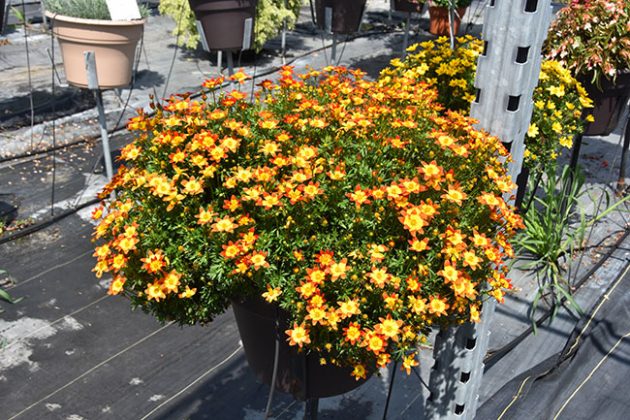 [11] Bidens Popstar Red Bicolor is built on its extremely compact, but large flower-producing cousin, Yellow Popstar. Heat-tolerant masses of bicolour flowers last much longer in hot conditions compared to other Bidens. Excellent in quarts for landscapes or large patio pots, as well as combinations.
[11] Bidens Popstar Red Bicolor is built on its extremely compact, but large flower-producing cousin, Yellow Popstar. Heat-tolerant masses of bicolour flowers last much longer in hot conditions compared to other Bidens. Excellent in quarts for landscapes or large patio pots, as well as combinations.
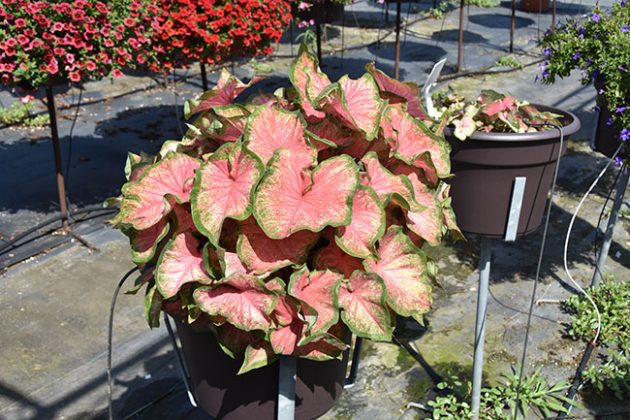 [12] Caladium Heart to Heart Chinook is one variety of caladium reintroduced to the Canadian market. If you want the colours of the caladium foliage to shine, plants should be sold at a young age to successfully acclimatize to the bright sun. Caladium can be grown in shaded areas. Absolutely great in landscape or large patio pots, or can be tried with upgraded mixes.
[12] Caladium Heart to Heart Chinook is one variety of caladium reintroduced to the Canadian market. If you want the colours of the caladium foliage to shine, plants should be sold at a young age to successfully acclimatize to the bright sun. Caladium can be grown in shaded areas. Absolutely great in landscape or large patio pots, or can be tried with upgraded mixes.
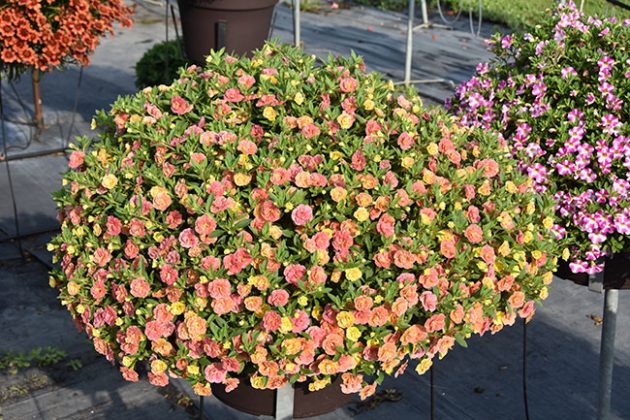 [13] Calibrachoa Chameleon Double Desert Rose (Trailing). Thousands of little colour-changing roses produce an incredible show that excels over many other varieties. Long lasting blooms with no deadheading needed, this variety thrives in the heat even if it can be produced at cool temperatures in the greenhouse. A favourite for large patio pots or large upgraded hanging baskets.
[13] Calibrachoa Chameleon Double Desert Rose (Trailing). Thousands of little colour-changing roses produce an incredible show that excels over many other varieties. Long lasting blooms with no deadheading needed, this variety thrives in the heat even if it can be produced at cool temperatures in the greenhouse. A favourite for large patio pots or large upgraded hanging baskets.
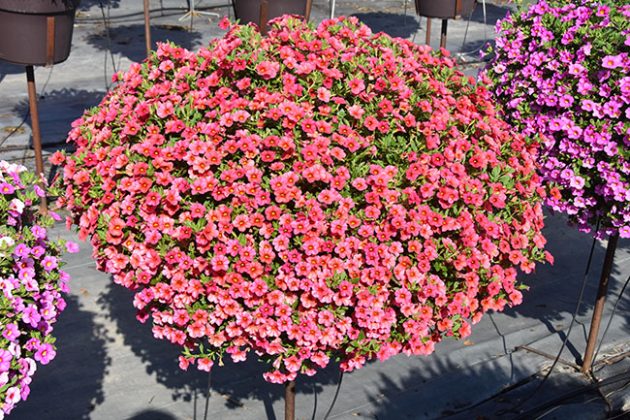 [14] Calibrachoa Kabloom Coral is a seed calibrachoa which has many advantages over vegetative: no shipment shock, lower chances of virus transmission, and having seed on hand that is ready to sow. An excellent garden performer all through the season, the series has four main colours and a star shaped one. Can be used in 4” pots to large containers. If grown in a 4”, it needs one pinch to encourage branching at an early stage, otherwise it grows straight up before it branches. Historically, one drawback has been its poor germination, but maybe this will be fixed for the next season.
[14] Calibrachoa Kabloom Coral is a seed calibrachoa which has many advantages over vegetative: no shipment shock, lower chances of virus transmission, and having seed on hand that is ready to sow. An excellent garden performer all through the season, the series has four main colours and a star shaped one. Can be used in 4” pots to large containers. If grown in a 4”, it needs one pinch to encourage branching at an early stage, otherwise it grows straight up before it branches. Historically, one drawback has been its poor germination, but maybe this will be fixed for the next season.
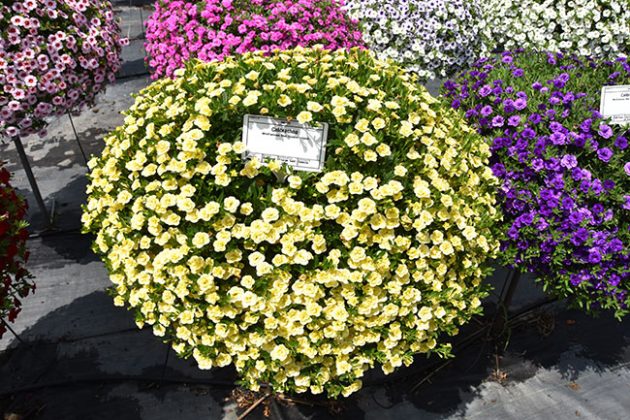 [15] Calibrachoa MiniFamous Neo Double Lemon is one colour of the double Mini Famous calibrachoa series that has excellent garden performance, excellent flower power, and no need for deadheading. Rain does not have any negative effect on it, and on the contrary, good rain will edge the pH down to a moderately acidic soil loved by calibrachoa. Excellent in upgraded large containers. This variety loves the heat but cooler weather makes the blooms somewhat larger.
[15] Calibrachoa MiniFamous Neo Double Lemon is one colour of the double Mini Famous calibrachoa series that has excellent garden performance, excellent flower power, and no need for deadheading. Rain does not have any negative effect on it, and on the contrary, good rain will edge the pH down to a moderately acidic soil loved by calibrachoa. Excellent in upgraded large containers. This variety loves the heat but cooler weather makes the blooms somewhat larger.
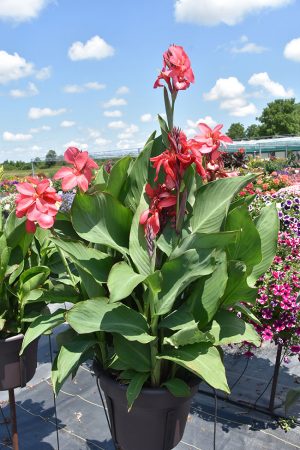 [16] Canna Cannova Rose is one colour in the Cannova series which is the most significant introduction since impatiens. Easy to produce, no viruses, and very versatile for use whether in landscape, in large containers or as a center plant in combinations. Cannas do not like high EC’s on the leaves and like to stay moist all the time. They can be enjoyed all through the summer, then stored in a cool place indoors to be forced again next year.
[16] Canna Cannova Rose is one colour in the Cannova series which is the most significant introduction since impatiens. Easy to produce, no viruses, and very versatile for use whether in landscape, in large containers or as a center plant in combinations. Cannas do not like high EC’s on the leaves and like to stay moist all the time. They can be enjoyed all through the summer, then stored in a cool place indoors to be forced again next year.
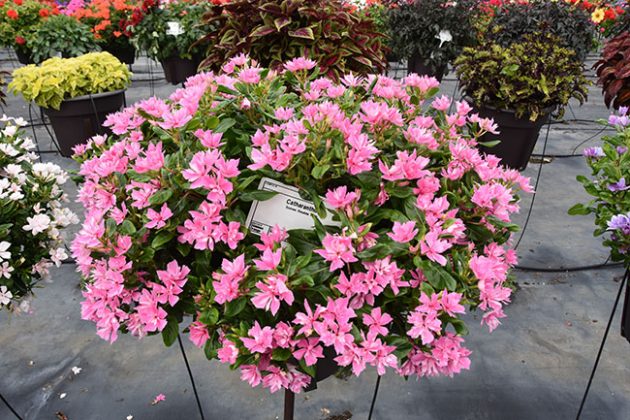 [17] Catharanthus Soiree Double Pink is new to our trials. It is a vegetative vinca with double flowers that love the heat. Rain has a positive effect on it by dropping the pH. Offers an excellent show all season long with no deadheading needed. Good for combinations, patio pots and landscapes.
[17] Catharanthus Soiree Double Pink is new to our trials. It is a vegetative vinca with double flowers that love the heat. Rain has a positive effect on it by dropping the pH. Offers an excellent show all season long with no deadheading needed. Good for combinations, patio pots and landscapes.
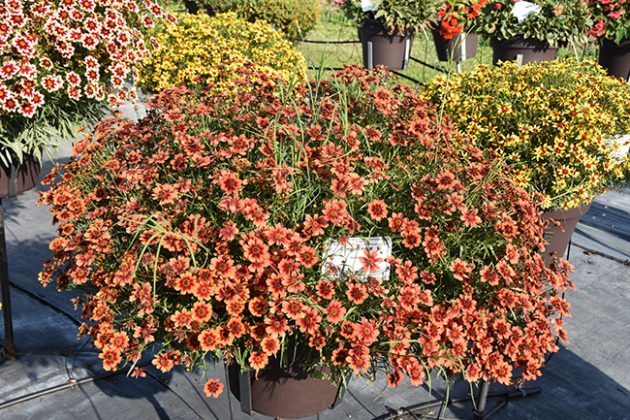 [18] Coreopsis Hybrid Desert Coral is one of the better Coreopsis on the market. Desert Coral has a unique fall colour, making it great for fall sales either alone, as it is a perennial, or in combinations. Long-lasting flowers in addition to strong flower rejuvenation make it one of the best garden performers past frost.
[18] Coreopsis Hybrid Desert Coral is one of the better Coreopsis on the market. Desert Coral has a unique fall colour, making it great for fall sales either alone, as it is a perennial, or in combinations. Long-lasting flowers in addition to strong flower rejuvenation make it one of the best garden performers past frost.
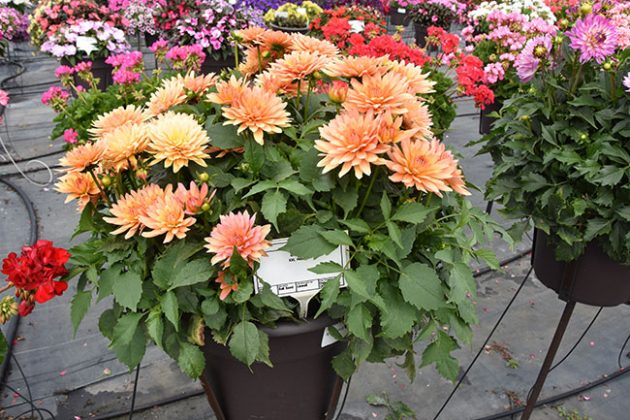 [19] Dahlia-XXL Hidalgo is one cultivar in a vigorous series of dahlias known for their large flowers. Like all dahlias, Hidalgo performs better planted in the ground so the roots and tubers do not become overheated, a problem that is the kiss of death for dahlias. Surprisingly, many of the dahlias in our trials did fairly well even though we grew them in pots placed on stands, but most of the dahlias that we received were young and tubers had not yet formed, which gave the plants a better chance at surviving the heat.
[19] Dahlia-XXL Hidalgo is one cultivar in a vigorous series of dahlias known for their large flowers. Like all dahlias, Hidalgo performs better planted in the ground so the roots and tubers do not become overheated, a problem that is the kiss of death for dahlias. Surprisingly, many of the dahlias in our trials did fairly well even though we grew them in pots placed on stands, but most of the dahlias that we received were young and tubers had not yet formed, which gave the plants a better chance at surviving the heat.
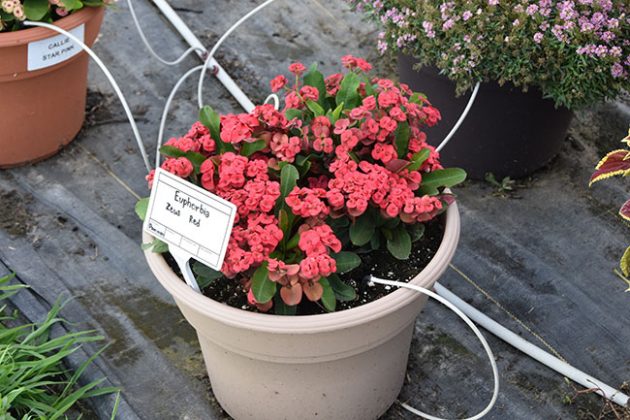 [20] Euphorbia Zeus Red is a compact euphorbia that has large flowers and can tolerate our hot summers. Bred for indoor use, we tried them outdoors and they performed well in full sun without any special treatment. A novelty to try for outdoor use.
[20] Euphorbia Zeus Red is a compact euphorbia that has large flowers and can tolerate our hot summers. Bred for indoor use, we tried them outdoors and they performed well in full sun without any special treatment. A novelty to try for outdoor use.
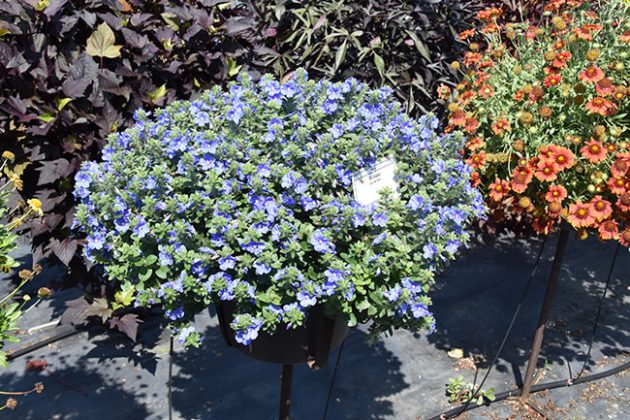 [21] Evolvulus Blue My Mind offers a pure blue colour that is not often found in garden plants. This variety flowered early in the season and held the flowers for an exceptionally long time as new ones formed. An excellent garden performer with no deadheading needed. Good for late spring sales in an upgraded container.
[21] Evolvulus Blue My Mind offers a pure blue colour that is not often found in garden plants. This variety flowered early in the season and held the flowers for an exceptionally long time as new ones formed. An excellent garden performer with no deadheading needed. Good for late spring sales in an upgraded container.
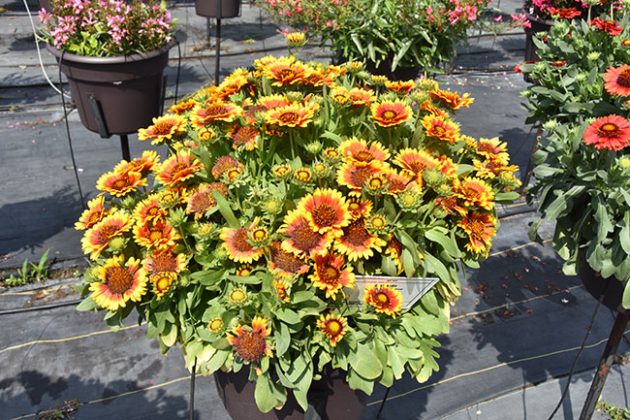 [22] Gaillardia Spintop Red Starburst is a first-year flowering perennial without any vernalization needed. Increase your productivity with these first-year flowering perennials by extending your spring program. It offers excellent colour that lasts the whole season with minimal deadheading. Red Starburst is great in gallons for landscapes or large containers to plant at the end of summer, or in combinations for fall sales.
[22] Gaillardia Spintop Red Starburst is a first-year flowering perennial without any vernalization needed. Increase your productivity with these first-year flowering perennials by extending your spring program. It offers excellent colour that lasts the whole season with minimal deadheading. Red Starburst is great in gallons for landscapes or large containers to plant at the end of summer, or in combinations for fall sales.
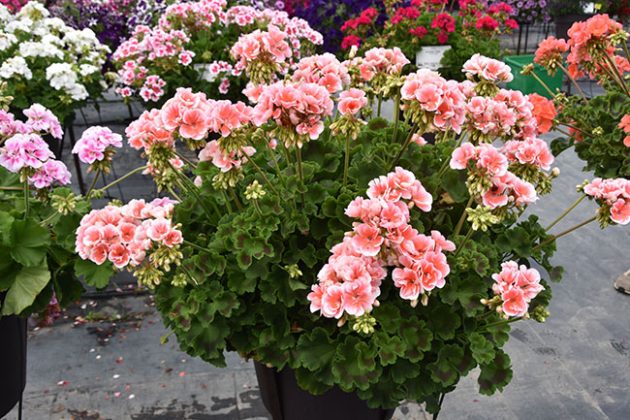 [23] Geranium Zonal Sunrise Salmon Light. I picked this as an example of a variety characteristic of light salmon geraniums. Many geraniums of the same colour will have similar habits across different series. I like the characteristics on Sunrise Salmon – strong flower stems with zoning leaves and great flower power.
[23] Geranium Zonal Sunrise Salmon Light. I picked this as an example of a variety characteristic of light salmon geraniums. Many geraniums of the same colour will have similar habits across different series. I like the characteristics on Sunrise Salmon – strong flower stems with zoning leaves and great flower power.
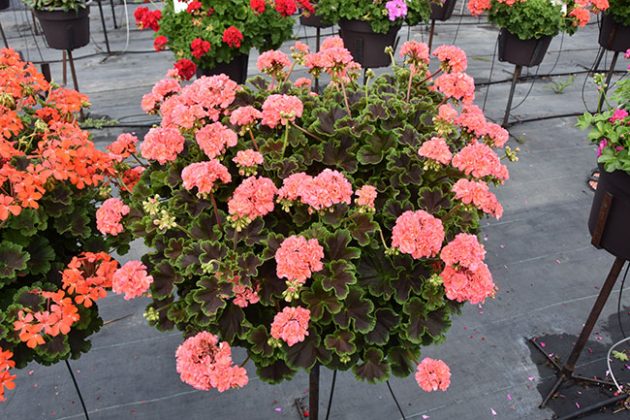 [24] Geranium Brocade Salmon Night is one colour in the Brocade series which can be grown just for its foliage, but along with the great foliage come masses of flowers that regenerate fast. Great in large hanging baskets and in combinations.
[24] Geranium Brocade Salmon Night is one colour in the Brocade series which can be grown just for its foliage, but along with the great foliage come masses of flowers that regenerate fast. Great in large hanging baskets and in combinations.
More to come
This is the first of a two-part series covering the Sawaya Garden Trials. Just remember what we always say: promising new varieties are there for you to try, not for making big programs with. If all goes well, then plan on larger programs for the next season. It will also be time to cancel some of the unprofitable programs.
Read on for part two of varietal highlights from the 2020 trials.
Melhem Sawaya of Focus Greenhouse Management is a consultant and research coordinator to the horticultural industry. Contact him at mel@focusgreenhousemanagement.com.
All photos by: T. Sawaya
Print this page